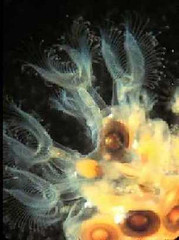It's like we're watching a disaster unfold while years of research goes on about how or if we can stop it. Personally I'd like to see more action. We know it's a problem and we know it goes well beyond Asian carp, and it impacts two vast water sheds.
Here's how the study group defines an "invasive" species:
"Invasive" – an alien or native species that can grow quickly, spread rapidly, and dominate an area to the point where native species are displaced, or have taken an area over because native species were eradicated by a previous event
The critters identified aren't what you might expect. Many of them are things like algae, bizarre fresh water invertibrates like Lophopodella carteri which is toxic, so there's nothing that can eat them:

There's the shrimp-like scud and the spiny water flea which are painful for fish to eat.
We're not looking at just one direction of infection...from the Mississippi to the Great Lakes. Heavens no. We're looking at bi-directional infestations...in more cases we're actually looking at creatures crossing from the Great Lakes into the Mississippi basin. Many of these invasive species came into the Great Lakes from distant lands, carried in freighters and deposited from ballast water. And from there, they now are able to move into the Mississippi water basin and the massive network of tributaries beyond....and why?
Because there is no longer the natural separation between the watersheds of the two water bodies. The Chicago Sanitary and Ship Canal joins the two water basins and accelerates the rates of invasive species infestation...much faster than native species can adapt to. Much faster than local natural resources management teams can respond to.
These two water sheds need to be separated. I'd like to see action now.
1 comment:
Honestly, what's surprising to me is that there isn't the political will to do this already. It just goes to show you how much power the shipping companies have.
Post a Comment